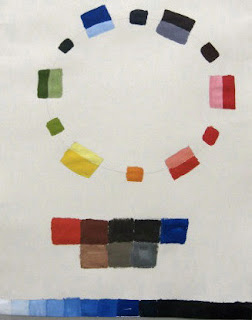
How to make this up- On a sheet of your 18"x24" paper use pencil to draw a large circle on one side, leaving a little margin between it and the edge of the paper. This will be for a color wheel. Then do the following:
Draw 3 boxes equally spaced around the wheel, half inside the circle, half out. Use these boxes for your primary colors- red, yellow, blue. (one in each) Put the full strength color in the part of the box outside the circle, the color plus white inside.
Draw 3 more boxes, halfway between each of the first 3. These are for the secondary colors that are made from the primaries that each is between. Use the primaries to mix the secondaries (orange, green, violet) making them visually halfway between- neither closer to one color nor the other. Again, full strength outside the circle, color plus white inside.
Draw 6 more boxes, spaced between the earlier 6 boxes. These can be smaller. These are for the intermediate colors, mixed from a primary and a secondary, such as blue-green, red-violet, yellow-orange, etc. For these you just need to make the intermediate color, no white mix is needed.
Complementary Color Mix- In the empty part of your page draw a row of 5 connected boxes, with 3 identical boxes adjacent to the middle 3. Choose a pair of complements, either red and green, or blue and orange. Put the primary in one end box of the row of 5, the secondary at the other end. In the middle box (#3) put a color that is an equal mix of primary and secondary. Add white and put it in the adjacent box. In the box next to the primary put a color that is mostly primary with a little bit of the secondary, and the opposite in the box next to the secondary, adding white to each and putting them in the adjacent boxes. For example, if you use red and green, box #1 would be solid red, #2 red with a little green, #3 equal red and green, #4 green with a little red, and #5 all green. The other 3 boxes are colors #2-4 with white added.
Tints and Shades- Draw a row of 15 boxes anywhere you have space left on the page. Choose a color and put it in the 8th (middle) box. For the remaining boxes, move it in gradual steps in one direction toward white, and the other direction toward black.
Examples of all three exercises can be seen above and below.
This is a portfolio exercise and must be made up by the end of the semester.














